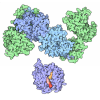[English] 日本語
 Yorodumi
Yorodumi- PDB-6zqu: Cryo-EM structure of mature Dengue virus 2 at 3.1 angstrom resolution -
+ Open data
Open data
- Basic information
Basic information
| Entry | Database: PDB / ID: 6zqu | ||||||||||||||||||
|---|---|---|---|---|---|---|---|---|---|---|---|---|---|---|---|---|---|---|---|
| Title | Cryo-EM structure of mature Dengue virus 2 at 3.1 angstrom resolution | ||||||||||||||||||
 Components Components | (Genome polyprotein) x 2 | ||||||||||||||||||
 Keywords Keywords | VIRUS / Flavivirus | ||||||||||||||||||
| Function / homology |  Function and homology information Function and homology informationflavivirin / symbiont-mediated suppression of host JAK-STAT cascade via inhibition of host TYK2 activity / host cell mitochondrion / symbiont-mediated suppression of host JAK-STAT cascade via inhibition of STAT2 activity / symbiont-mediated suppression of host cytoplasmic pattern recognition receptor signaling pathway via inhibition of MAVS activity / ribonucleoside triphosphate phosphatase activity / viral capsid / double-stranded RNA binding / nucleoside-triphosphate phosphatase / channel activity ...flavivirin / symbiont-mediated suppression of host JAK-STAT cascade via inhibition of host TYK2 activity / host cell mitochondrion / symbiont-mediated suppression of host JAK-STAT cascade via inhibition of STAT2 activity / symbiont-mediated suppression of host cytoplasmic pattern recognition receptor signaling pathway via inhibition of MAVS activity / ribonucleoside triphosphate phosphatase activity / viral capsid / double-stranded RNA binding / nucleoside-triphosphate phosphatase / channel activity / monoatomic ion transmembrane transport / clathrin-dependent endocytosis of virus by host cell / mRNA (guanine-N7)-methyltransferase / methyltransferase cap1 / molecular adaptor activity / methyltransferase cap1 activity / mRNA 5'-cap (guanine-N7-)-methyltransferase activity / RNA helicase activity / protein dimerization activity / host cell perinuclear region of cytoplasm / host cell endoplasmic reticulum membrane / RNA helicase / symbiont-mediated suppression of host type I interferon-mediated signaling pathway / symbiont-mediated activation of host autophagy / RNA-directed RNA polymerase / serine-type endopeptidase activity / viral RNA genome replication / RNA-directed RNA polymerase activity / fusion of virus membrane with host endosome membrane / viral envelope / lipid binding / virion attachment to host cell / host cell nucleus / virion membrane / structural molecule activity / ATP hydrolysis activity / proteolysis / extracellular region / ATP binding / metal ion binding / membrane Similarity search - Function | ||||||||||||||||||
| Biological species |  Dengue virus 2 Dengue virus 2 | ||||||||||||||||||
| Method | ELECTRON MICROSCOPY / single particle reconstruction / cryo EM / Resolution: 3.1 Å | ||||||||||||||||||
 Authors Authors | Renner, M. / Dejnirattisai, W. / Carrique, L. / Serna Martin, I. / Karia, D. / Ilca, S.L. / Ho, S.F. / Kotecha, A. / Keown, J.R. / Mongkolsapaya, J. ...Renner, M. / Dejnirattisai, W. / Carrique, L. / Serna Martin, I. / Karia, D. / Ilca, S.L. / Ho, S.F. / Kotecha, A. / Keown, J.R. / Mongkolsapaya, J. / Screaton, G.R. / Grimes, J.M. | ||||||||||||||||||
| Funding support |  United Kingdom, 5items United Kingdom, 5items
| ||||||||||||||||||
 Citation Citation |  Journal: Nat Commun / Year: 2021 Journal: Nat Commun / Year: 2021Title: Flavivirus maturation leads to the formation of an occupied lipid pocket in the surface glycoproteins. Authors: Max Renner / Wanwisa Dejnirattisai / Loïc Carrique / Itziar Serna Martin / Dimple Karia / Serban L Ilca / Shu F Ho / Abhay Kotecha / Jeremy R Keown / Juthathip Mongkolsapaya / Gavin R ...Authors: Max Renner / Wanwisa Dejnirattisai / Loïc Carrique / Itziar Serna Martin / Dimple Karia / Serban L Ilca / Shu F Ho / Abhay Kotecha / Jeremy R Keown / Juthathip Mongkolsapaya / Gavin R Screaton / Jonathan M Grimes /    Abstract: Flaviviruses such as Dengue (DENV) or Zika virus (ZIKV) assemble into an immature form within the endoplasmatic reticulum (ER), and are then processed by furin protease in the trans-Golgi. To better ...Flaviviruses such as Dengue (DENV) or Zika virus (ZIKV) assemble into an immature form within the endoplasmatic reticulum (ER), and are then processed by furin protease in the trans-Golgi. To better grasp maturation, we carry out cryo-EM reconstructions of immature Spondweni virus (SPOV), a human flavivirus of the same serogroup as ZIKV. By employing asymmetric localised reconstruction we push the resolution to 3.8 Å, enabling us to refine an atomic model which includes the crucial furin protease recognition site and a conserved Histidine pH-sensor. For direct comparison, we also solve structures of the mature forms of SPONV and DENV to 2.6 Å and 3.1 Å, respectively. We identify an ordered lipid that is present in only the mature forms of ZIKV, SPOV, and DENV and can bind as a consequence of rearranging amphipathic stem-helices of E during maturation. We propose a structural role for the pocket and suggest it stabilizes mature E. | ||||||||||||||||||
| History |
|
- Structure visualization
Structure visualization
| Movie |
 Movie viewer Movie viewer |
|---|---|
| Structure viewer | Molecule:  Molmil Molmil Jmol/JSmol Jmol/JSmol |
- Downloads & links
Downloads & links
- Download
Download
| PDBx/mmCIF format |  6zqu.cif.gz 6zqu.cif.gz | 294.3 KB | Display |  PDBx/mmCIF format PDBx/mmCIF format |
|---|---|---|---|---|
| PDB format |  pdb6zqu.ent.gz pdb6zqu.ent.gz | 241.7 KB | Display |  PDB format PDB format |
| PDBx/mmJSON format |  6zqu.json.gz 6zqu.json.gz | Tree view |  PDBx/mmJSON format PDBx/mmJSON format | |
| Others |  Other downloads Other downloads |
-Validation report
| Summary document |  6zqu_validation.pdf.gz 6zqu_validation.pdf.gz | 403.6 KB | Display |  wwPDB validaton report wwPDB validaton report |
|---|---|---|---|---|
| Full document |  6zqu_full_validation.pdf.gz 6zqu_full_validation.pdf.gz | 426.6 KB | Display | |
| Data in XML |  6zqu_validation.xml.gz 6zqu_validation.xml.gz | 35 KB | Display | |
| Data in CIF |  6zqu_validation.cif.gz 6zqu_validation.cif.gz | 51.4 KB | Display | |
| Arichive directory |  https://data.pdbj.org/pub/pdb/validation_reports/zq/6zqu https://data.pdbj.org/pub/pdb/validation_reports/zq/6zqu ftp://data.pdbj.org/pub/pdb/validation_reports/zq/6zqu ftp://data.pdbj.org/pub/pdb/validation_reports/zq/6zqu | HTTPS FTP |
-Related structure data
| Related structure data |  11370MC  6zqiC  6zqjC  6zqvC  6zqwC C: citing same article ( M: map data used to model this data |
|---|---|
| Similar structure data |
- Links
Links
- Assembly
Assembly
| Deposited unit | 
|
|---|---|
| 1 | x 60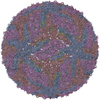
|
- Components
Components
| #1: Protein | Mass: 54501.902 Da / Num. of mol.: 3 / Source method: isolated from a natural source / Source: (natural)  Dengue virus 2 / References: UniProt: D0EPS0, UniProt: P29990*PLUS Dengue virus 2 / References: UniProt: D0EPS0, UniProt: P29990*PLUS#2: Protein | Mass: 8421.879 Da / Num. of mol.: 3 / Source method: isolated from a natural source / Source: (natural)  Dengue virus 2 / References: UniProt: O11875 Dengue virus 2 / References: UniProt: O11875#3: Sugar | ChemComp-NAG / Has ligand of interest | N | Has protein modification | Y | |
|---|
-Experimental details
-Experiment
| Experiment | Method: ELECTRON MICROSCOPY |
|---|---|
| EM experiment | Aggregation state: PARTICLE / 3D reconstruction method: single particle reconstruction |
- Sample preparation
Sample preparation
| Component | Name: Dengue virus 2 / Type: VIRUS / Details: Virus cultivated in C6/36 cells / Entity ID: #1-#2 / Source: NATURAL |
|---|---|
| Molecular weight | Experimental value: NO |
| Source (natural) | Organism:  Dengue virus 2 / Strain: 16681 Dengue virus 2 / Strain: 16681 |
| Details of virus | Empty: NO / Enveloped: YES / Isolate: SEROTYPE / Type: VIRION |
| Natural host | Organism: Aedes aegypti |
| Buffer solution | pH: 7.4 / Details: PBS buffer |
| Specimen | Embedding applied: NO / Shadowing applied: NO / Staining applied: NO / Vitrification applied: YES |
| Specimen support | Grid type: C-flat-2/1 |
| Vitrification | Instrument: FEI VITROBOT MARK IV / Cryogen name: ETHANE-PROPANE |
- Electron microscopy imaging
Electron microscopy imaging
| Experimental equipment |  Model: Tecnai Polara / Image courtesy: FEI Company |
|---|---|
| Microscopy | Model: FEI POLARA 300 |
| Electron gun | Electron source:  FIELD EMISSION GUN / Accelerating voltage: 300 kV / Illumination mode: FLOOD BEAM FIELD EMISSION GUN / Accelerating voltage: 300 kV / Illumination mode: FLOOD BEAM |
| Electron lens | Mode: BRIGHT FIELD |
| Image recording | Electron dose: 32 e/Å2 / Detector mode: SUPER-RESOLUTION / Film or detector model: GATAN K2 SUMMIT (4k x 4k) |
- Processing
Processing
| Software | Name: PHENIX / Version: dev_3699: / Classification: refinement | ||||||||||||||||||||||||||||
|---|---|---|---|---|---|---|---|---|---|---|---|---|---|---|---|---|---|---|---|---|---|---|---|---|---|---|---|---|---|
| EM software |
| ||||||||||||||||||||||||||||
| CTF correction | Type: PHASE FLIPPING AND AMPLITUDE CORRECTION | ||||||||||||||||||||||||||||
| Particle selection | Num. of particles selected: 6676 | ||||||||||||||||||||||||||||
| Symmetry | Point symmetry: I (icosahedral) | ||||||||||||||||||||||||||||
| 3D reconstruction | Resolution: 3.1 Å / Resolution method: FSC 0.143 CUT-OFF / Num. of particles: 2938 / Symmetry type: POINT | ||||||||||||||||||||||||||||
| Refine LS restraints |
|
 Movie
Movie Controller
Controller






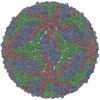
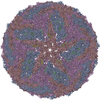
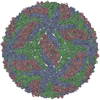
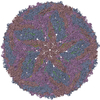



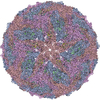

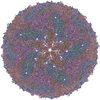
 PDBj
PDBj

